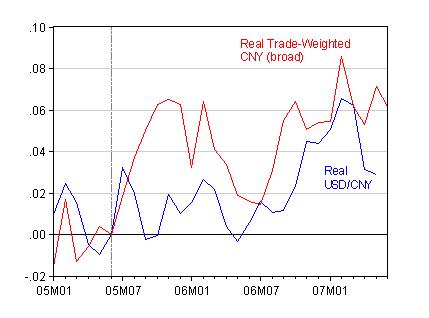More speculation on the Yuan’s prospects. From Bloomberg:
Yuan May Trade Freely After Olympics, UOB’s Suan Says (Update2)
By Christina Soon
July 16 (Bloomberg) — China may allow the yuan to trade freely after Beijing hosts the Olympics next year, seeking to curb excessive lending and cool the economy, said Suan Teck Kin, an economist at United Overseas Bank Ltd.
The government will probably allow a so-called free-floating currency a year after reshuffling its leadership in October, Singapore-based Suan said in an interview. He predicts the currency will strengthen 1.9 percent by the end of the year to 7.43 per dollar and 6.9 percent to 7.08 by the end of 2008.
Restrictions on inflows and outflows of money for investment purposes, or the capital account, now allow the central bank to dominate the currency market. Sales of yuan have limited its gains to 9.4 percent since the end of a dollar link in July 2005, not enough to fend off a threat of sanctions from U.S. lawmakers.
“They have to adopt a free-float system; it’s not a question of whether they will, but a question of when,” said Suan at United Overseas, Singapore’s second-biggest bank. “After the Olympics, the new leadership will be firmly in place.”
The yuan had its biggest weekly gain since the end of the fixed exchange rate in the five days ended July 13. The currency closed at 7.5678 against the dollar in Shanghai at 5:30 p.m. It is allowed to fluctuate by up to 0.5 percent a day against the dollar either side of a rate fixed by the central bank.
…
A free-floating yuan is unlikely to exist after the Olympics because there needs to be enough derivatives products for traders and banks to hedge against foreign-exchange risks, said Ma Jun, an economist at Deutsche Bank AG in Hong Kong.
“It will take at least five years,” Ma said. “It requires a range of institutional reforms and strengthening of risk management. It also requires a broad balance of supply and demand for the currency.”
Forwards and swaps are currently the only two products in China’s yuan derivatives market. Derivatives are contracts whose value is derived from stocks, bonds, loans, currencies and commodities, or linked to specific events such as changes in interest rates or the weather.
In some sense, this is a really long term issue; somehow I suspect the “free floating” characterization used in the article is a rather loose one — barely anybody in the world free floats their currency. (In narrow terms, even the US doesn’t to the extent that the exchange rate enters at all into the calculations of monetary or fiscal policy.) In the short term, we need to ponder the pace at which China manages its exchange rate, and what effect accelerated appreciation would have.

Figure 1: Log real trade weighted value of Chinese Yuan (blue, left scale), and Chinese trade balance in bn USD, at annual rate (red, right scale), and 12-month trailing moving average (green, right scale). Source: BIS and IMF, IFS.
From the figure, it’s clear there’s no simple relationship between the CNY’s value and the trade balance. But of course, that’s why man created multiple linear regression (which gives you a hint at what I’m spending my time on these days). Teasing out the relationship between these macro variables is difficult, noted in these posts [1], [2].
And what is the pace of CNY appreciation? In nominal terms, the answer is straightforward — at least against the USD: 8% (in log terms). In trade weighted terms, 6%. The difference highlights the fact that the important measure (overall CNY appreciation) depends upon variations in the USD, as long as the Chinese manage the CNY against the USD.

Figure 2: Log nominal USD/CNY exchange rate rescaled to 0 at 2005M06 (blue), and trade weighted value of Chinese Yuan (red); up is an appreciation of the CNY. Source: IMF, IFS, and BIS.
Actually, it’s the real value of the currency that matters (as hinted at in Figure 1). In Figure 3, the real (CPI deflated) analogues are depicted. In this case — because of fairly high inflation rates in the US vis a vis other Chinese trading partners — the trade weighted CNY has risen more in value than the against the USD.

Figure 3: Log real USD/CNY exchange rate rescaled to 0 at 2005M06 (blue), and trade weighted value of Chinese Yuan (red); up is an appreciation of the CNY. Source: IMF, IFS, BIS, and author’s calculations.
One question is whether the surge in the Chinese trade balance is associated with the depreciation about a year ago, or is in spite of the appreciation in recent quarters. For an econometric take on this question, stay tuned.
Technorati Tags: China, imports,
exports,
Chinese trade surplus,
renminbi,
exchange rate,
Chinese yuan, and trade weighted exchange rate.
menzie by 8% pace of appreciation, i presume you mean the cumulative appreciation since early 2005 has been 8% (v the $) — 8% would seem a bit high (tho it would be welcome) for the annual pace of appreciation in 07.
brad setser: Absolutely, that’s the cumulative. More would have been welcome, especially on a trade weighted basis.